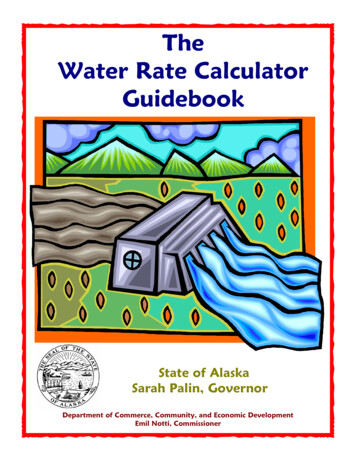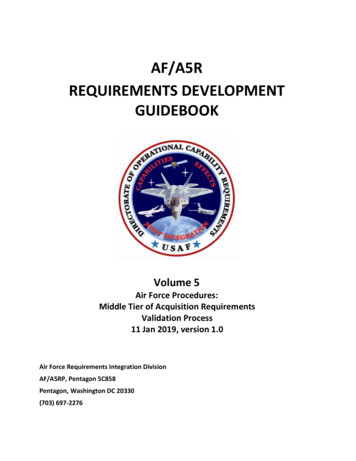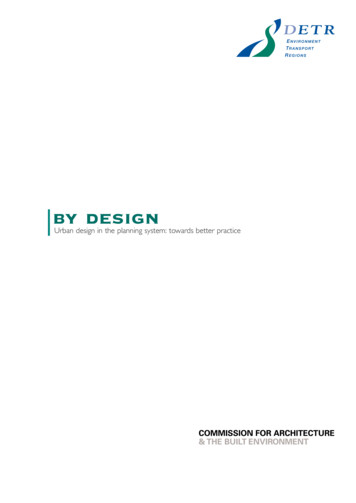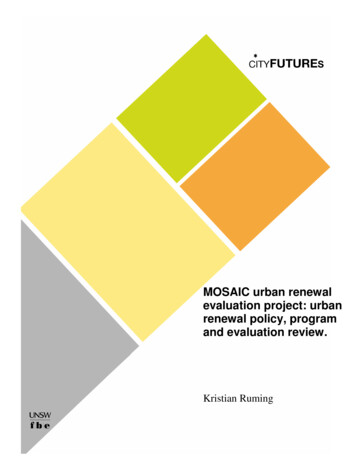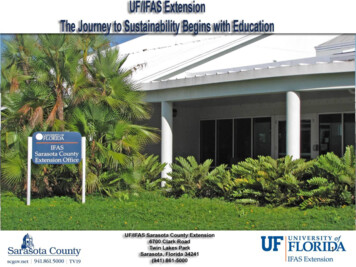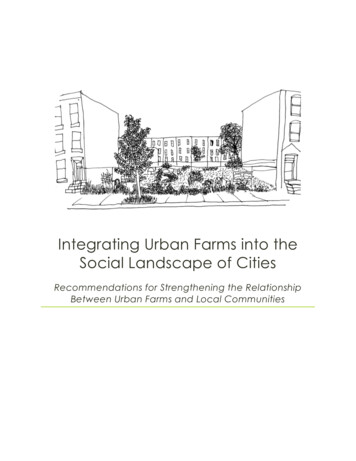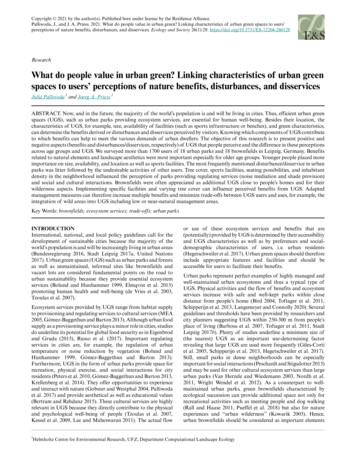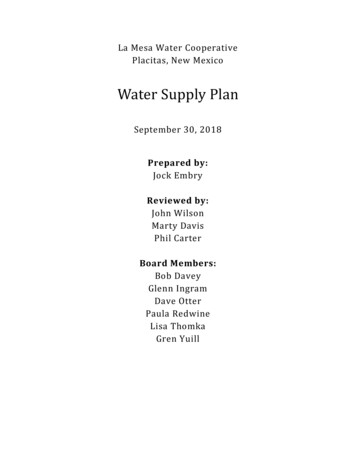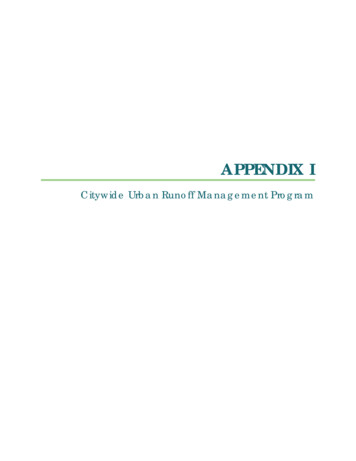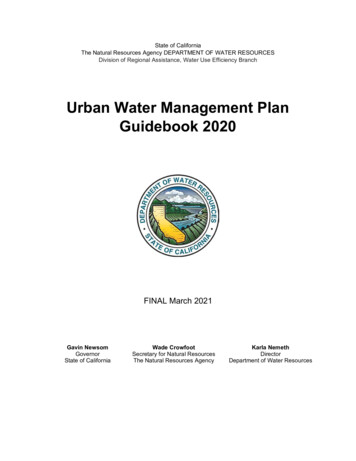
Transcription
State of CaliforniaThe Natural Resources Agency DEPARTMENT OF WATER RESOURCESDivision of Regional Assistance, Water Use Efficiency BranchUrban Water Management PlanGuidebook 2020FINAL March 2021Gavin NewsomGovernorState of CaliforniaWade CrowfootSecretary for Natural ResourcesThe Natural Resources AgencyKarla NemethDirectorDepartment of Water Resources
This page left blank intentionally.
State of CaliforniaGavin NewsomCalifornia Natural Resources AgencyWade Crowfoot, Secretary for Natural ResourcesDepartment of Water ResourcesKarla Nemeth, DirectorCindy Messer Chief Deputy DirectorMichele Banonis Assistant Chief Deputy DirectorErin MellonAssistant DirectorPublic Affairs OfficeSpencer KennerChief CounselMichael SabbaghianDeputy DirectorSecurity and Emergency ManagementKasey SchimkeAssistant DirectorLegislative AffairsErich KochDeputy DirectorFlood Management and Dam SafetyKatherine S. KishabaDeputy DirectorBusiness OperationsAnecita AgustinezGovernment and Community LiaisonTed CraddockDeputy DirectorState Water ProjectKrisopher TjernellDeputy Director Integrated Water ManagementJohn Andrew and Jeanine JonesAssistants to the Deputy Director
This report was prepared under the direction ofArthur Hinojosa, ManagerByWater Use Efficiency BranchSabrina Cook . Environmental Program Manager IFethi Benjemaa . Environmental Program Manager IJulia Ekstrom .Senior Environmental Scientist, SupervisorGwen Huff . Senior Environmental Scientist, SpecialistBetsy Vail . Environmental ScientistNancy King . Water Resources EngineerJames Campagna . Office Assistant
Urban Water Management Planning Workgroup MembersCamrosa Water DistrictIan PrichardCity of Palo Alto UtilitiesKara DaileyContra Costa Water DistrictCristina EstrellaDelta Stewardship CouncilAnthony NavaseroEast Bay Municipal Utility District Eastern Municipal Water DistrictGinger ChenGordon NgEKI Environment & Water, Inc.Kat WueflingFoothill Municipal Water DistrictNina JazmadarianGolden State Water CompanyEdwin deLeonInland Empire Utilities AgencyLisa Morgan-PeralesIndividualMartha DavisIrvine Ranch Water DistrictKellie WelchKennedy Jenks ConsultantsMeredith ClementLos Angeles Department of Water and PowerBenjamin WongMetropolitan Water DistrictEdgar FandialanMunicipal Water District of Orange CountyGarvey De La TorreRancho California Water DistrictJeff KirshbergSan Diego County Water AuthorityAlexi SchnellSan Jose WaterCourtney RubinSanta Rosa Water, Sonoma County RegionColin CloseSanta Clarita Valley WaterAgencyDirk MarksSonoma Water and Sonoma-Marin SavingWater PartnershipPaul PiazzaSweetwater AuthoritySue MosburgValley WaterAshley ShannonVentura WaterJennifer TriboWater Systems Consulting, Inc.Spencer WatermanWater UXAbe SerranoWest Yost AssociatesElizabeth DrayerWestern Municipal Water DistrictMallory Gandara
This page left blank intentionally.
DisclaimerThis 2020 UWMP Guidebook was prepared by the California Department ofWater Resources to aid urban water suppliers who must comply with therequirements of the California Water Code Section I, Part 2.55 and Part 2.6.Urban water suppliers subject to the requirements are solely responsible forcompliance with the requirements and may use this Guidebook if theychoose. DWR has voluntarily opted to provide this Guidebook to makecomplying with the California Water Code simpler for urban water suppliers,and to assist these suppliers in creating a useful planning document.For assistance interpreting the content of this document, please contactCalifornia Department of Water Resources Water Use Efficiency staff atUWMPhelp@water.ca.gov.
PrefaceThe 2020 Urban Water Management Plan Guidebook (Guidebook) is offeredto help Suppliers prepare their UWMP in a way that is consistent with thelegal requirements. It also provides guidance for preparing an “enhanced”planning document that may be more useful to Suppliers, other resourceplanners, or policy and decision makers. This Guidebook has been revisedfrom the 2015 version to reflect the changes in law, recommend analyticalprotocols, reflect variations between the 2015 and 2020 cycles, and toimprove the guidance based on feedback from urban water suppliers andother stakeholders. The 2020 UWMP Guidebook has been updated from the2015 Guidebook to reflect the new legislation, and to potentially improve theusefulness of a Supplier’s 2020 UWMP. To remain consistent with the 2015UWMP guidebook, this 2020 UWMP Guidebook is structured by topic andwritten in the order recommended for Suppliers to organize their ownUWMP.New to this Guidebook is that each chapter includes an introductory sectionto describe the purpose and importance of covering the topic (Importance),how to focus on the essentials required (Focus), how to enhance coveringthe topic using recommended and best practices (Enhancements), and newrequirements since the previous 2015 UWMPs (New Requirements).Associated workbooks and tools are provided to assist Suppliers in preparinginformation for electronic submittal through DWR’s WUE Data Portal. ThisGuidebook will reference these tools and workbooks as described below.SBx7-7 Verification Form. Each Retail Urban Water Supplier must implementgoals of the Water Conservation Act of 2009, also known as the SB X7-7, toreduce urban per capita water use by 20-percent by December 2020. Tocomply, Retail Suppliers that are preparing a 2020 UWMP must provide abaseline and urban water use target in GPCD.SBx7-7 2020 Compliance Form. This workbook includes the series of tablesto show compliance with the goals of the Water Conservation Act of 2009,also known as the SB X7-7, to reduce urban per capita water use by 20percent by December 2020.Submittal Tables. This workbook includes the DWR standardized submittaltables updated for new legislation and dates. Those tables applicable toretailers or wholesalers only are labelled with an R or W, respectively. Thosetable names without an R or W apply to both retailers and wholesalers.Potable and non-potable versions of Submittal Tables are offered in this
workbook as optional for the Supplier’s planning purposes. All are marked asoptional.Energy Use Tables. This offers a selection of tables from which Suppliers canchoose for structuring the required information on energy use. See Chapter6 of this guidebook and Appendix O for specifics. The tables used bySuppliers would be included as part of the narrative of their UWMP (or as anappendix) and the filled-out table or tables would be uploaded as an excelworkbook attachment to the UWMP into the WUE Data Portal.Planning Tool. This workbook tool is an optional tool Suppliers can use toreport and assess water use and supply and conduct the ReliabilityAssessment and Drought Risk Assessment on monthly to annual timeincrements. Results from this tool can be used to populate the SubmittalTables.Potable and Non-Potable Planning Tool (P-NP Planning Tool). This workbooktool is the Planning Tool that allows for separate reporting and calculationsof potable and non-potable use and supplies. Results from this tool can beused to populate the optional potable/non-potable Submittal Tables.
AcknowledgementsThis UWMP Guidebook was prepared with assistance from: Tully & Young,Stantec Consulting Services, Inc., the technical stakeholder UWMPGuidebook Development Workgroup, and the DWR Climate Change Program.
Urban Water Management Plan Introduction and OverviewContents1.0Urban Water Management Plan Introduction and Overview . 1-11.1Recommended UWMP Organization . 1-81.2UWMPs in Relation to Other Efforts . 1-101.3UWMPs and Grant or Loan Eligibility . 1-111.4Demonstration of Consistency with the Delta Plan forParticipants in Covered Actions . 1-121.5Tips for UWMP Preparers . 1-132.0Plan Preparation . 2-12.1Plan Preparation . 2-22.2Basis for Preparing a Plan. 2-32.2.1Public Water Systems . 2-32.2.2Suppliers Serving Multiple Service Areas/Public WaterSystems . 2-42.3Regional Planning . 2-52.4Individual or Regional Planning and Compliance . 2-62.4.1Regional UWMP . 2-72.4.2Regional Alliance . 2-82.5Fiscal or Calendar Year and Units of Measure. 2-102.5.1Fiscal or Calendar Year . 2-102.5.2Reporting Complete 2020 Data . 2-112.5.3Units of Measure. 2-122.6Coordination and Outreach . 2-122.6.1Wholesale and Retail Coordination . 2-122.6.2Coordination with Other Agencies and the Community . 2-142.6.3Notice to Cities and Counties . 2-163.0System Description . 3-13.1General Description . 3-23.2Service Area Boundary Maps . 3-33.3Service Area Climate . 3-53.4Service Area Population and Demographics . 3-63.4.1Service Area Population . 3-63.4.2Other Social, Economic, and Demographic Factors . 3-8UWMP Guidebook 2020i
Urban Water Management Plan Introduction and Overview3.54.0Land Uses within Service Area . 3-9Water Use Characterization . 4-14.1Non-Potable Versus Potable Water Use . 4-64.2Past, Current, and Projected Water Use by Sector . 4-94.2.1Water Use Sectors Listed in Water Code . 4-114.2.2Water Use Sectors in Addition to Those Listed in WaterCode . 4-144.2.3Past Water Use. 4-164.2.4Distribution System Water Loss. 4-164.2.5Current Water Use . 4-194.2.6Projected Water Use. 4-224.2.7Characteristic Five-Year Water Use . 4-274.3Worksheets and Reporting Tables . 4-304.3.1Optional Planning Tool Use Analysis Worksheet. 4-304.3.2DWR 2020 UWMP Submittal Tables . 4-324.4Water Use for Lower Income Households . 4-394.5Climate Change Considerations . 4-415.0SBX7-7 Baselines, Targets, and 2020 Compliance . 5-15.1Guidance for Wholesale Suppliers . 5-25.2SB X7-7 Forms and Summary Tables . 5-35.2.1SB X7-7 Verification Form (Baselines and Targets) . 5-35.2.2SB X7-7 2020 Compliance Form . 5-35.2.3Submittal Tables 5-1 and 5-2 . 5-35.2.4Regional UWMP/Regional Alliance . 5-45.3Baseline and Target Calculations for 2020 UWMPs . 5-55.3.1Supplier Submitted 2015 UMWP, No Change to ServiceArea . 5-55.3.2Supplier Did Not Submit 2015 UWMP . 5-65.3.3Supplier Newly Subject to UWMP Requirements . 5-65.3.4Distribution Area Expansion . 5-65.3.5Distribution Area Contraction . 5-65.3.6Large Partial Customers Become Whole Customers . 5-75.4Methods for Calculating Population and Gross Water Use . 5-75.4.1Service Area Population . 5-75.4.2Gross Water Use. 5-11UWMP Guidebook 2020ii
Urban Water Management Plan Introduction and Overview5.52020 Compliance Daily Per-Capita Water Use (GPCD) . 5-155.5.12020 Adjustments for Factors Outside of Supplier’s Control . 5-165.5.2Special Situations . 5-195.5.3If Supplier Does Not Meet 2020 Target . 5-195.66.0Regional Alliance . 5-20Water Supply Characterization . 6-16.1Water Supply Analysis Overview . 6-46.1.1Specific Analysis Applicable to All Water Supply Sources . 6-56.1.2Other Characterization Considerations . 6-86.1.3Optional Planning Tool . 6-86.2Narrative Sections for Supplier’s UWMP Water SupplyCharacterization . 6-116.2.1Purchased or Imported Water . 6-126.2.2Groundwater . 6-136.2.3Surface Water . 6-196.2.4Stormwater . 6-206.2.5Wastewater and Recycled Water . 6-206.2.6Desalinated Water Opportunities . 6-356.2.7Water Exchanges and Transfers . 6-366.2.8Future Water Projects . 6-386.2.9Summary of Existing and Planned Sources of Water . 6-406.2.10 Special Conditions. 6-466.3Submittal Tables Completion Using the Optional PlanningTool . 6-486.3.1Submittal Table 6-1: Groundwater Volume Pumped. 6-486.3.2Submittal Table 6-2 R: Wastewater Collected WithinService Area in 2020 . 6-486.3.3Submittal Table 6-3 (R or W): Wastewater Treatment andDischarge Within Service Area in 2020 . 6-486.3.4Submittal Table 6-4: Recycled Water in Service Area . 6-496.3.5Submittal Table 6-5: 2015 Recycled Water Use ProjectionCompared to 2020 Actual . 6-496.3.6Submittal Table 6-6: Methods to Expand Future RecycledWater Use . 6-496.3.7Submittal Table 6-7: Expected Future Water SupplyProjects or Programs . 6-49UWMP Guidebook 2020iii
Urban Water Management Plan Introduction and Overview6.3.8Submittal Table 6-8: Water Supplies – Actual . 6-506.3.9Submittal Table 6-9: Water Supplies – Projected . 6-506.47.0Energy Use . 6-51Water Service Reliability and Drought Risk Assessment . 7-17.1Introduction . 7-17.2Water Service Reliability Assessment . 7-47.2.1Service Reliability - Constraints on Water Sources . 7-57.2.2Service Reliability - Year Type Characterization. 7-77.2.3Service Reliability - Supply and Demand Comparison. 7-107.2.4Description of Management Tools and Options . 7-187.3Drought Risk Assessment . 7-207.3.1DRA Data, Methods, and Basis for Water ShortageConditions . 7-227.3.2DRA Individual Water Source Reliability . 7-237.3.3DRA Total Water Supply and Use Comparison . 7-237.3.4Optional Planning Tool Workbook . 7-288.0Water Shortage Contingency Plan . 8-18.1Water Supply Reliability Analysis . 8-78.2Annual Water Supply and Demand Assessment Procedures . 8-78.3Six Standard Water Shortage Levels . 8-118.4Shortage Response Actions . 8-148.4.1Demand Reduction. 8-168.4.2Supply Augmentation . 8-178.4.3Operational Changes . 8-198.4.4Additional Mandatory Restrictions . 8-198.4.5Emergency Response Plan . 8-208.4.6Seismic Risk Assessment and Mitigation Plan. 8-208.4.7Shortage Response Action Effectiveness . 8-238.5Communication Protocols . 8-258.6Compliance and Enforcement . 8-268.7Legal Authorities. 8-278.8Financial Consequences of WSCP . 8-288.9Monitoring and reporting . 8-338.10WSCP Refinement Procedures . 8-34UWMP Guidebook 2020iv
Urban Water Management Plan Introduction and Overview8.11Special Water Feature Distinction . 8-348.12Plan Adoption, Submittal and Availability . 8-358.13Resources and References . 8-359.0Demand Management Measures. 9-19.1Demand Management Measures for Wholesale Suppliers . 9-39.1.1Metering . 9-39.1.2Public Education and Outreach . 9-49.1.3Water Conservation Program Coordination and StaffingSupport . 9-49.1.4Other Demand Management Measures . 9-49.1.5Asset Management. 9-59.1.6Wholesale Supplier Assistance Programs . 9-59.2Existing Demand Management Measures for Retail Suppliers. 9-59.2.1Water Waste Prevention Ordinances . 9-69.2.2Metering . 9-79.2.3Conservation Pricing. 9-89.2.4Public Education and Outreach . 9-99.2.5Programs to Assess and Manage Distribution System RealLoss . 9-109.2.6Water Conservation Program Coordination and StaffingSupport . 9-109.2.7Other Demand Management Measures . 9-109.3Reporting Implementation . 9-119.3.1Implementation Over the Past Five Years. 9-119.3.2Implementation to Achieve Water Use Targets. 9-129.410.0Water Use Objectives (Future Requirements) . 9-12Plan Adoption, Submittal, and Implementation . 10-110.1Inclusion of All 2020 Data . 10-310.2Notice of Public Hearing . 10-410.2.1 Notice to Cities and Counties . 10-410.2.2 Notice to the Public . 10-710.3Public Hearing and Adoption . 10-810.3.1 Public Hearing . 10-910.3.2 Adoption . 10-910.4Plan Submittal . 10-10UWMP Guidebook 2020v
Urban Water Management Plan Introduction and Overview10.4.1 Submitting a UWMP and Water Shortage Contingency Planto DWR . 10-1010.4.2 Electronic Data Submittal . 10-1110.4.3 Submitting a UWMP, including WSCP, to the CaliforniaState Library . 10-1110.4.4 Submitting a UWMP to Cities and Counties . 10-1210.5Public Availability . 10-1210.6Notification to Public Utilities Commission . 10-1210.7Amending an Adopted UWMP or Water ShortageContingency Plan . 10-1310.7.1 Amending a UWMP . 10-1310.7.2 Amending a Water Shortage Contingency Plan. 10-13FiguresFigure 7-1. Supply Worksheet Data to Paste into the DRA Worksheet . 7-29Figure 7-2. Use Worksheet Data to Paste into the DRA Worksheet . 7-30Figure 7-3. Excerpt of DRA Worksheet Showing Location of WSCPAdjustments. 7-31Figure 7-4. Example 1 DRA Worksheet Scenario . 7-32Figure 7-5. Example 2 DRA Worksheet Scenario . 7-33Figure 7-6. Example 3 DRA Worksheet Scenario . 7-34Figure 8-1. Example of Corresponding Relationships Between aSupplier’s 2015 Shortage Levels and the 2020 WSCP MandatedShortage Levels . 8-14TablesSubmittal Table 2-1 Retail: Public Water Systems . 2-5Submittal Table 2-2. Plan Identification Type . 2-10Submittal Table 2-3. Supplier Identification . 2-11Submittal Table 2-4 Retail: Water Supplier Information Exchange . 2-13Submittal Table 2-4 Wholesale: Water Supplier Information Exchange. 2-14Submittal Table 3-1 Retail. Population - Current and Projected . 3-8Submittal Table 3-1 Wholesale. Population - Current and Projected . 3-8Table 6-1 Retail. Groundwater Volume Pumped . 6-18Table 6-2 Retail. Wastewater Collected Within Area in 2020 . 6-26Table 6-3 Retail. Wastewater Treatment and Discharge Within ServiceArea in 2020 . 6-27Table 6-4 Retail. Current and Projected Recycled Water DirectBeneficial Uses Within Service Area . 6-32Table 6-5 Retail. 2015 Recycled Water Use Projection Compared to2020 Actual . 6-33UWMP Guidebook 2020vi
Urban Water Management Plan Introduction and OverviewTable 6-4 Wholesale. Current and Projected Retailers ProvidedRecycled Water Within Service Area . 6-34Table 6-5 Wholesale. 2015 UWMP Recycled Water Use ProjectionCompared to 2020 Actual . 6-34Table 6-6 Retail. Methods to Expand Future Recycled Water Use . 6-35Table 6-7 Retail. Expected Future Water Supply Projects or Programs . 6-40Table 6-7 Wholesale. Expected Future Water Supply Projects orPrograms . 6-40Table 6-8 Retail. Water Supplies – Actual. 6-44Table 6-8 Wholesale. Water Supplies – Actual. 6-45Table 6-9 Retail. Water Supplies – Projected . 6-46Table 6-9 Wholesale. Water Supplies – Projected . 6-46Table 7-1 Retail. Basis of Water Year Data (Water Service ReliabilityAssessment) . 7-9Table 7-2 Retail. Normal Year Supply and Demand Comparison . 7-13Optional Table 7-2 Retail. Normal Year Supply and DemandComparison – Potable . 7-14Optional Table 7-2 Retail. Normal Year Supply and DemandComparison – Non-Potable . 7-14Table 7-3 Retail. Single Dry Year Supply and Demand Comparison. 7-16Table 7-4 Retail. Multiple Dry Years Supply and Demand Comparison . 7-18Table 7-5. Five-Year Drought Risk Assessment Tables to AddressWater Code Section 10635(b) . 7-27Table 8-1. Water Shortage Contingency Plan Levels. 8-13Table 8-2. Demand Reduction Actions . 8-17Table 10-1 Retail. Notification to Cities and Counties . 10-6Table 10-1 Wholesale. Notification to Cities and Counties . 10-7AppendicesAppendix A. California Water Code – Urban Water Management PlanningAppendix B. Changes to the California Water Code Since 2015 UWMPAppendix C. Voluntary Reporting of Delta RelianceAppendix D. Regional Water Planning and ReportingAppendix E. UWMP Submittal Tables, SB X7‐7 Verification Form, SB X7-72020 Compliance Form, and SB X7-7 Forms for a RegionalAllianceAppendix F. ChecklistAppendix G. GlossaryAppendix H. ReferencesAppendix I. Considering Climate Change ImpactsAppendix J. California Code of Regulations – Industrial Process WaterExclusionUWMP Guidebook 2020vii
Urban Water Management Plan Introduction and OverviewAppendix K. Estimating Future Water SavingsAppendix L. Water Loss AuditingAppendix M. Recycled WaterAppendix N. Case Study on Integrated Rate Design and CommunicationAppendix O. Energy ReportingAppendix P. SB X7-7 Baseline and Target CalculationsAppendix Q. Annual Water Supply and Demand Assessment (AnnualAssessment) Guidance – In DevelopmentUWMP Guidebook 2020viii
Urban Water Management Plan Introduction and OverviewAbbreviations and AcronymsACSAmerican Community SurveyActUrban Water Management Planning ActAMIAdvanced Metering InfrastructureAMRAutomatic Meter ReadingAnnual Assessmentannual water supply demand assessmentCCRCalifornia Code of RegulationsCDPcensus designated placeCEQACalifornia Environmental Quality ActCIMISCalifornia Irrigation Management InformationSystemCPUCCalifornia Public Utilities CommissionDeltaSacramento-San Joaquin DeltaDMMDemand Management MeasuresDOFCalifornia Department of FinanceDRADrought Risk AssessmentDWRCalifornia Department of Water ResourceseARElectronic Annual Reporting SystemERPEmergency Response PlanGPCDGallons Per Capita Per DayGSAGroundwater Sustainability AgencyGSPGroundwater Sustainability PlanHOAHomeowners’ AssociationsIRWMIntegrated Regional Water ManagementLAFCOLocal Agency Formation CommissionLegislatureState of California LegislatureM&Imunicipal and industrialUWMP Guidebook 2020ix
Urban Water Management Plan Introduction and OverviewMethodologiesMethodologies for Calculating Baseline andCompliance Urban Per Capita Water UseNAICSNorth American Industry Classification SystemNOAANational Oceanographic and SIDPublic Water System Identification NumberR-GPCDResidential GPCDRetail Supplierurban retail water supplierRUWMPRegional Urban Water Management PlanSB X7-7Senate Bill Extraordinary Session 7-7SGMASustainable Groundwater Management ActState Water BoardState Water Resources Control BoardSupplierurban water supplierSWPState Water ProjectU.S.United StatesUWMPUrban Water Management PlanWater CodeCalifornia Water CodeWSCPWater Shortage Contingency PlanWUE Data PortalWater Use Efficiency Data PortalUWMP Guidebook 2020x
Urban Water Management Plan Introduction and OverviewUWMP Guidebook 2020Chapter 11.0 Urban Water Management PlanIntroduction and OverviewIn 1983, the State of California Legislature (Legislature) enacted theUrban Water Management Planning Act (Act). The law required anurban water supplier (Supplier), providing water for municipalpurposes to more than 3,000 custo
Potable and Non-Potable Planning Tool (P-NP Planning Tool). This workbook tool is the Planning Tool that allows for separate reporting and calculations of potable and non-potable use and supplies. Results from this tool can be used to populate the optional potable/non-potable Submittal Tables.
